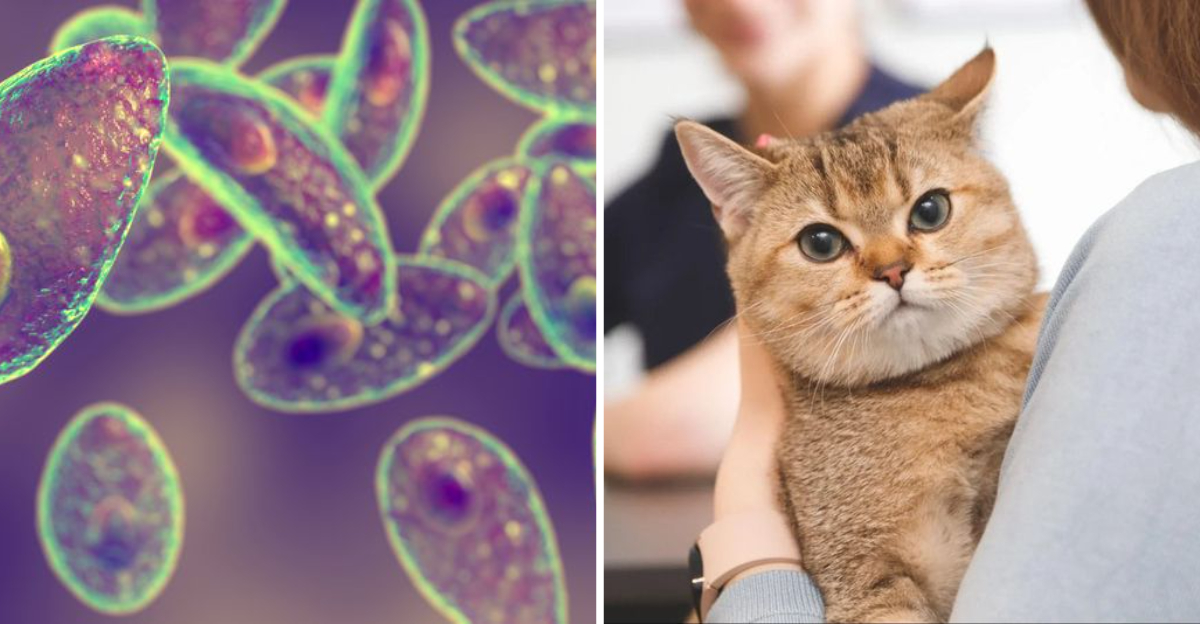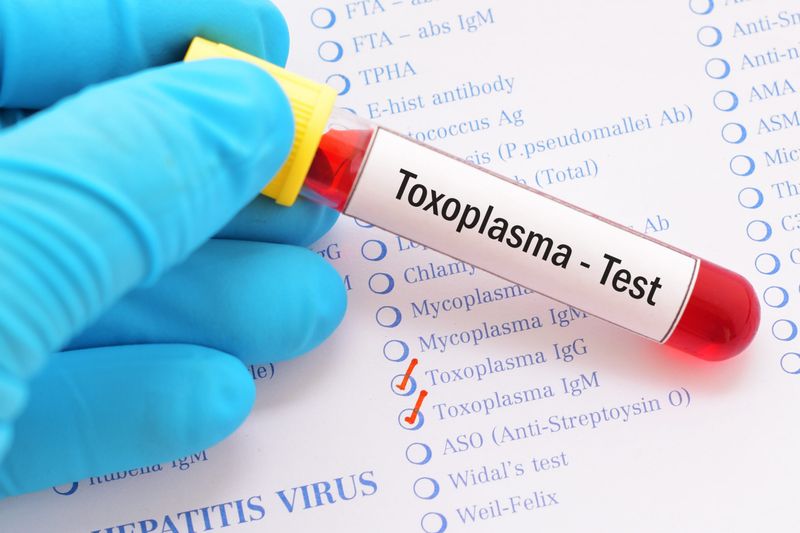How A Cat Parasite Could Seriously Impact Your Brain Function, According To Research

Ever wondered if your furry feline friend could be affecting your brain? Scientists have discovered a parasite called Toxoplasma gondii that lives in cats and can infect humans.
This microscopic invader might be doing more than just making a home in your body – it could actually change how your brain works! Recent research reveals some surprising ways this tiny organism impacts human behavior and health.
Toxoplasma gondii

Toxoplasma gondii is a single-celled parasite that thrives in cats’ digestive systems. Cats become infected by eating contaminated prey like mice or birds, then shed the parasite’s eggs in their poop for up to two weeks.
Scientists estimate that this sneaky organism has infected up to one-third of the world’s population! Most people never know they have it because their immune system keeps it in check.
The parasite forms tiny cysts in brain and muscle tissue, where it can remain dormant for years or even decades. These cysts are the key to understanding how this parasite might mess with your mind.
How Humans Get Infected

Accidentally ingesting cat feces particles is the most common way people get infected. This happens when changing cat litter without washing hands afterward or eating unwashed vegetables from gardens where cats have pooped.
Eating undercooked meat from infected animals like pork, lamb, or venison can also transmit the parasite. The meat contains tiny cysts that survive until properly cooked.
Pregnant women can pass the infection to their unborn babies, which is why doctors warn expectant mothers to avoid changing cat litter. Gardeners should wear gloves when working in soil that might contain cat waste.
Risk-Taking Behavior Changes

Infected people show subtle but measurable increases in risk-taking behaviors. Studies found they’re more likely to start their own businesses, engage in extreme sports, or make risky financial decisions.
Czech scientist Jaroslav Flegr discovered that infected individuals have slower reaction times in driving simulations and are 2.6 times more likely to be involved in traffic accidents! The parasite seems to reduce fear and caution in the human brain.
Researchers believe these behavioral changes might be evolutionary adaptations that help the parasite spread. When infected mice lose their fear of cats, they’re more easily caught – allowing the parasite to return to its preferred host.
Personality Alterations

Your personality might shift in subtle ways if you’re infected. Research shows men with the parasite tend to become more suspicious, jealous, and rule-breaking after infection. Women often show opposite changes – becoming more warm-hearted, outgoing, and rule-abiding.
Infected people score differently on personality tests, particularly in traits related to novelty-seeking and self-control. These changes don’t happen overnight but develop gradually as the parasite forms cysts in the brain.
The parasite appears to affect dopamine production – a brain chemical involved in pleasure, motivation, and social behavior. This might explain why personality changes persist long after the initial infection.
Links To Mental Health Disorders

Multiple studies have found connections between Toxoplasma infection and schizophrenia. Infected people are nearly 2.7 times more likely to develop this serious mental illness, according to a major analysis combining 42 studies.
The parasite has also been linked to obsessive-compulsive disorder, anxiety, and depression. Scientists believe inflammation caused by the infection might trigger these conditions in genetically vulnerable people.
Brain scans show that infected individuals have subtle structural differences, particularly in areas controlling fear and anxiety. These physical changes might explain why the parasite is associated with such a wide range of mental health impacts.
Memory And Learning Effects

Laboratory studies show the parasite can impair memory and learning abilities. Infected mice perform worse in maze tests and have trouble remembering previously learned information. Human research suggests similar effects.
A 2019 study found that infected adults scored lower on tests measuring working memory, processing speed, and concentration. College students with the infection showed slightly lower GPAs than their uninfected peers.
The parasite forms cysts in the hippocampus – the brain region crucial for forming new memories. These cysts trigger low-level inflammation that disrupts normal brain cell communication, potentially explaining these cognitive effects.
The Suicide Connection

Among the most disturbing findings is the link between Toxoplasma infection and increased suicide risk. Studies across 20 European nations found that national suicide rates correlate with infection rates in the population.
Infected people show higher levels of self-directed violence and suicide attempts. One Danish study tracked over 45,000 women who gave birth and found those with Toxoplasma infections had a 53% higher risk of self-harm or suicide attempts.
The parasite affects serotonin levels in the brain – a neurotransmitter that regulates mood and is targeted by many antidepressant medications. This biochemical change might explain the increased suicide risk among infected individuals.
Hormone Disruption

Toxoplasma messes with your body’s hormone production in surprising ways. The parasite increases testosterone levels in men while decreasing them in women, potentially explaining the different personality changes seen between genders.
Your stress response gets hijacked too. Infected people show altered cortisol patterns – the hormone that helps manage stress. This disruption might contribute to anxiety and mood disorders linked to the infection. The parasite can even affect pregnancy hormones.
Infected pregnant women show different hormone profiles, which might explain why the infection sometimes causes miscarriages or birth defects when contracted during pregnancy.
Neurological Disease Connections

Recent research has uncovered potential links between Toxoplasma and neurodegenerative diseases. Several studies found higher rates of Parkinson’s disease among people with the parasite, suggesting it might trigger or accelerate the condition.
Alzheimer’s disease might also be connected. The inflammation caused by parasite cysts resembles the brain inflammation seen in Alzheimer’s patients. Scientists are investigating whether the infection could be one factor that increases risk for cognitive decline later in life.
Multiple sclerosis patients show higher rates of Toxoplasma antibodies in their blood compared to healthy people. This autoimmune condition might be triggered partly by the body’s response to the parasite in genetically susceptible individuals.
Protecting Yourself From Infection

Cook all meat thoroughly to kill any parasite cysts – especially pork, lamb, and venison. Use a food thermometer to ensure meat reaches at least 145°F (63°C) for whole cuts and 160°F (71°C) for ground meat. When changing cat litter, wear disposable gloves and wash hands thoroughly afterward.
Change the litter daily since the parasite becomes infectious 1-5 days after being shed. Keep outdoor sandboxes covered when not in use to prevent cats from using them as litter boxes.
Wash all fruits and vegetables thoroughly before eating, especially if they might have been grown in soil where cats could access. Gardeners should wear gloves when handling soil to prevent accidental ingestion of parasite eggs.
Testing And Treatment Options

Blood tests can detect Toxoplasma antibodies, showing if you’ve been infected. However, standard tests can’t tell you when the infection occurred or if it’s actively causing problems. Newer tests that measure specific antibody types can sometimes determine if the infection is recent.
For healthy people with normal immune systems, doctors usually don’t prescribe treatment because the infection typically causes no symptoms. When treatment is needed, medications like pyrimethamine and sulfadiazine can help control the parasite.
Pregnant women, babies, and people with weakened immune systems receive more aggressive treatment since the infection poses greater risks for these groups. No treatments currently exist to remove dormant cysts from the brain.






